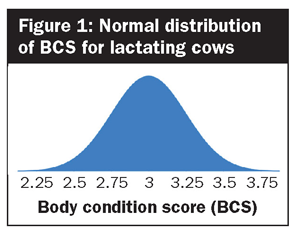The author is a retired professor of dairy science from South Dakota State University. He is now a consultant with Dellait Dairy Nutrition & Management.
In contemporary dairy production, customizing feeding groups based on cows’ physiological state is standard practice as we aim to meet specific nutrient requirements and enhance health, productivity, and overall well-being. Utilizing multiple total mixed ration (TMR) feeding groups offers economic advantages and potential nutrient cost reductions.
To address variability within groups, “lead feeding” is commonly used, providing extra nutrients to high-performing cows. This involves adjusting the feeding regimen using the average milk production plus one standard deviation or the 83rd percentile method.
Separate lead factors for net energy of lactation (NEL) and crude protein (CP) have been proposed, with suggested values of 133% for NEL and 126% for CP when feeding one group. For two groups, the lead factors differ: 119% for NEL and 113% for CP for the low-production group; and 130% for NEL and 125% for CP for the high-production group. Lead-feeding strategies allow dairy farmers to tailor feed regimens to each group’s specific needs, ensuring optimal nutrition and maximizing production potential.
Research conducted in the mid-1970s observed a net gain of $30 per cow per year in income over feed costs (IOFC) when using a two TMR strategy compared to a single TMR approach. Other studies reported an IOFC advantage of $60 per cow per year for two TMR feedings, despite lower annual milk production. Subsequent studies in the 1990s and 2000s also reported gains ranging from $10 to $44 per cow per year in IOFC when transitioning from one to multiple TMR groups.
These studies highlighted the significance of grouping criteria, diet nutrient specifications, milk production effects, and the number and size of the groups. They also emphasized the importance of considering factors such as body weight (BW) and body condition score (BCS) changes in grouping strategies. Optimal grouping based on similar nutrient requirements allows for diet formulations that reflect the actual needs of each group and their variability.
Genetic factors significantly influence variation in body condition score, with approximately 60% of the differences attributed to them. This genetic component may explain why some cows accumulate body reserves at a faster rate, leading to overconditioned cows with lower milk production that may need to be dried off early.

Lead feeding is practical and physiologically sensible for fresh cows during the first three weeks of lactation. However, the impact of lead feeding diminishes for cows that have experienced less weight loss. At this stage, separating cows based on continued weight loss or weight gain and feeding them different TMRs can ensure a more uniform high pen.
This approach aims to provide cows genetically predisposed to weight loss with a more nutrient-dense diet, promoting a positive energy balance, synchronized breeding activity, and a higher proportion of cows entering the breeding cycle. Cows with lower BCS have lower pregnancy rates achieved through artificial insemination, while cows that gain condition have higher pregnancy rates.
Allocation is critical
In livestock production, effective feed allocation is crucial for optimizing returns on investment. It involves allocating the right type of feed to animals with varying nutrient requirements within carefully selected groups, aiming for maximum productivity and profitability. Technological advancements like 3D cameras have made feed allocation more efficient.
Using a computer interface and sorting gate, homogeneous groups of cows can be created for feeding. The goal is to have a group of fit, breedable cows rather than simply aesthetically pleasing ones. Figure 2 showcases the distribution of BCS obtained using a 3D camera in a successful dairy farm.

During early lactation, cows typically experience a loss of body condition, which stabilizes around 60 days in milk. Transitioning cows from the fresh cow diet to a high-pen ration, and dividing it based on BCS dynamics, can expedite their return to ovarian cyclicity.
The dynamics of BCS in the low group also require attention. Many farms have cows in the low-production pen that gain excessive body condition as they approach the end of lactation, leading to issues during the dry period. By dividing these cows into two low groups, feed allocation and BCS homogenization during the dry and close-up periods can be improved. Strategic management of feeding and resource allocation based on BCS dynamics optimizes cow health, productivity, and well-being throughout lactation and the dry period.
In summary, proper allocation of resources, including feed and labor, is crucial in livestock production. Efficient allocation ensures animals receive the necessary nutrients and care, leading to improved productivity, animal health, and profitability. By strategically managing resources and considering animal requirements, farmers can create an environment conducive to optimal performance.
For our 1,000+ Producers
Welcome to this new section in Hoard’s Dairyman, tailored specifically to you. Here we will provide content focused on the unique requirements and challenges found on operations milking more than 1,000 cows.










